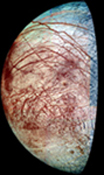By Gail Jacobs
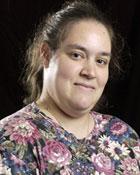 An expert in processing spacecraft images of the planets, Dr. Cynthia Phillips is particularly interested in the search for active geological processes on Mars, Europa, Io, and beyond. These worlds represent locations where liquid water, a possible indicator of life, could be present today. Cynthia, who joined the SETI Institute in 2000, has compared the images taken of Jupiter's moons Europa and Io by the Galileo and Voyager spacecraft to search for any changes that may have occurred on their surfaces. In the case of Europa, which is believed to have a mammoth, liquid ocean beneath its icy surface, active regions would pinpoint locations where liquid water is located close to the surface. She has also used her detection techniques to document ongoing volcanic activity on Jupiter's pizza-like moon, Io.
An expert in processing spacecraft images of the planets, Dr. Cynthia Phillips is particularly interested in the search for active geological processes on Mars, Europa, Io, and beyond. These worlds represent locations where liquid water, a possible indicator of life, could be present today. Cynthia, who joined the SETI Institute in 2000, has compared the images taken of Jupiter's moons Europa and Io by the Galileo and Voyager spacecraft to search for any changes that may have occurred on their surfaces. In the case of Europa, which is believed to have a mammoth, liquid ocean beneath its icy surface, active regions would pinpoint locations where liquid water is located close to the surface. She has also used her detection techniques to document ongoing volcanic activity on Jupiter's pizza-like moon, Io.
Cynthia, what motivates you?
The discovery of the unknown - what's out there? Is there life on Europa? How do these planets and satellites work? What are they made of? What kind of geology goes on there? What do these places look like? What would it be like to be there? These are big questions but I find them really fascinating and I want to know the answers.
Describe your research project for us.
My background is in planetary geology, so I'm interested in looking at pretty pictures of the surfaces of planets in the solar system. I'm all about the pictures! I'm currently working on a few different projects. My primary interest is in the icy satellites of the outer solar system, but I've recently started thinking about Mars as well. There is so much Mars data. I resisted it for awhile but was pulled in by the gorgeous pictures of Mars.
I have an ongoing project that includes looking at images of Europa taken by the Galileo spacecraft. During the 1995-2003 Galileo mission, the data return was constrained because the high gain antenna on the spacecraft didn't open correctly. As a result, the dataset is much smaller than a fully functional mission like Cassini. We did get some pretty amazing pictures, however. They represent the only high-resolution pictures of Jupiter's moons we're going to have for a very long time, so the dataset from Galileo, while small, is extremely valuable.
This NASA-funded proposal involves taking the color images and performing a scattered light correction on them. It's a complicated process and we'll need to do this on every single color image. I've been working on this project for the last two years. My student intern, Mario Valenti, has been doing a huge amount of work and has helped to get this procedure up and running. No one had done it before because it's such a painstaking process. We have now completed initial steps on a lot of images and we're starting to get to the finished product on a couple. This work will not only produce very pretty pictures of the surface but also ones that are fully calibrated. Once they're calibrated, we'll be able to combine these pictures with observations of the surface taken by another Galileo instrument called a mapping spectrometer, to improve our understanding of the composition of Europa's surface.
You recently got another project funded to look at craters on icy satellites of both Jupiter and Saturn, using both Galileo and Cassini data. What will that involve?
I'm going to take pictures of craters and make stereo, or 3-D, digital elevation models of the craters. That lets us come up with a profile so you can actually see the topography or shape of the crater. That's a really key result because based on their diameter, we know how deep they should be. But since these craters are in ice, it flows in a process known as crater relaxation. They start as a simple bowl shape. Over time, the floor gets higher so the crater becomes shallower, but the diameter doesn't change. We know from the diameter how deep the craters were originally, and then we can measure their current depth from the 3-D model. That can tell us something about the subsurface composition, the thermal histories -- the temperature with depth over time -- and also something about the age of the crater. I'm really excited to work on this project.
You additionally just received NASA funding for a Mars project in which you'll look at slope streaks on Mars.  There are dark streaks that form on cliffs or crater walls on Mars. What is so interesting is they are some of the youngest features on Mars. We've seen new streaks form during Viking and during the Mars Global Surveyor Mission, so they are forming now. Some people think they actually require liquid. If they require some sort of liquid water right at the surface now, that would be really exciting for astrobiology. I'll be looking at how these streaks form and also how they fade over time. The photo to the left is the Wishbone slope streak on Mars. Image credit: NASA/JPL/University of Arizona
There are dark streaks that form on cliffs or crater walls on Mars. What is so interesting is they are some of the youngest features on Mars. We've seen new streaks form during Viking and during the Mars Global Surveyor Mission, so they are forming now. Some people think they actually require liquid. If they require some sort of liquid water right at the surface now, that would be really exciting for astrobiology. I'll be looking at how these streaks form and also how they fade over time. The photo to the left is the Wishbone slope streak on Mars. Image credit: NASA/JPL/University of Arizona
Why should your research matter to the general public?
Planetary geology is interesting because we can use processes on other planets and satellites in the solar system to help us understand how planets work. One of the overarching goals of planetary science is what we call "comparative planetology," in which we compare what we see on other planets to what we know about the Earth. Earth is a really complicated place - it has water, plate tectonics, volcanoes, and more importantly, it has life. Earth has trees and animals and people that are modifying the planet, so it's really hard to isolate single geologic processes.
If we look elsewhere in the solar system, we can find worlds like Europa where the surface is covered with all these cracks and ridges. It's primarily a tectonic world. Or we can look at Jupiter's moon, Io, which is the most volcanic body in the solar system. It's covered with volcanoes, plumes and lava flows. By looking at other planets and satellites, we can learn how these processes work in the extreme, and this can help us better understand the Earth.
Europa's Frozen Surface. Europa, a moon of Jupiter, appears as a thick crescent in this enhanced-color image from NASA's Galileo spacecraft, which has been orbiting Jupiter since 1995. While at the University of Arizona, Tucson, Dr. Cynthia Phillips used this image in a detailed search for current geologic activity on Europa. Image processing: Cynthia Phillips. Image Credit: NASA/JPL/University of Arizona. Click on picture for larger image.
A common thread throughout my work involves thinking about habitable environments for life. If we look at places like Mars and Europa, we can think about what life needs to survive and perhaps where else we can look for life in the solar system. Europa has a huge ocean of water under its icy surface. Some people, myself included, think it's one of the best places to currently look for life in the solar system. That's why studying features like craters on Europa and the composition of the surface is so important as we start to learn whether these could actually be environments for life.
You stated you're "all about the pictures." Why are pictures so important?
Images are accessible to the public. When you ask the public what they know about NASA, they'll say the space shuttle and astronauts because the images of them are so accessible. Or they'll mention the Hubble Space Telescope because it takes gorgeous astronomical pictures. They may also mention pictures of the solar system taken during various missions. It's those iconic pictures that stick in people's minds. A picture is worth more than a thousand words. You don't have to be able to play an instrument to enjoy listening to music, and you don't have to be a scientist in order to enjoy looking at pictures.
What do you currently consider your biggest challenge?
There are not enough pictures. Mars has had many spacecraft - in orbit and on the surface - so there is a lot of data. But when looking at the outer solar system, missions are few and far between. The Voyager spacecraft flew by the Jupiter system in 1979 and 1980. Then about 15 years later, we started seeing pictures taken by the Galileo spacecraft. It's going to more than 15 years before we get any more pictures from the proposed Europa Jupiter System Mission. It takes a long time to get to the outer solar system and it costs a lot of money. If you're an outer solar system scientist, you really have to get very good at making the best use of archival datasets as well as planning for new pictures when the time arrives.
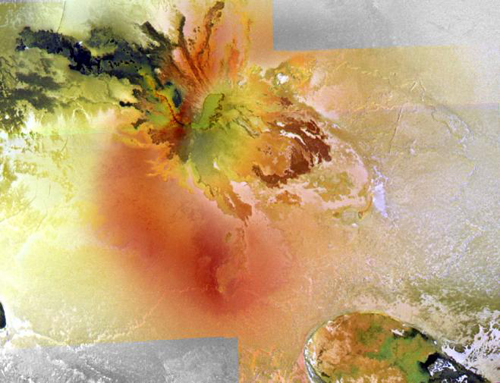
Culann Patera, Io, in false color. Culann Patera, one of the most colorful volcanic centers on Io, is the centerpiece of this mosaic of the best high-resolution, color view of Io yet returned by NASA's Galileo spacecraft. The color mosaic shows the complex relationships between the diffuse red deposit, the more confined green deposit, and the various colored lava flows. The images were taken on November 25, 1999 during Galileo's 25th orbit at a distance of 20,000 kilometers (12,500 miles) from Io. Image processing: Cynthia Phillips. Image Credit: NASA/JPL/University of Arizona
You are interested in science education and are the director of the SETI Institute's REU (Research Experience for Undergraduates) program. In fact, you brought it to the Institute. Tell us about your personal REU experience.
I'm very interested in getting students involved in research. As an astronomy major in college, I had the opportunity to participate in an REU internship program at the National Optical Astronomy Observatory (NOAO) in Tucson, Arizona. It was an amazing experience taking pictures with a telescope, analyzing the data, and being with other students who were working on other research projects. It was so inspiring. I thought, "This is the coolest thing ever!" That experience totally sold me on a career in research.
Describe the REU program in general.
The REU intern program is run by the National Science Foundation (NSF), and has been around for years. The NSF funds these programs at colleges, universities, observatories, and other research institutes around the country. They are focused in the disciplines covered by the NSF -- biology, chemistry, astronomy, physics, and so on. The NSF is very concerned with making sure the U.S. has enough bright people heading into graduate careers in science. Through their various studies, they've found these undergraduate research programs are key training programs and are prime pathways into science careers. The REU program is a well-studied and very good concept.
If you're an undergraduate student thinking about going to graduate school and having a career as a scientist, an REU program is one way to give it a try. Students at smaller colleges may not have active research programs or their professors may not work with undergraduates. Having the opportunity to do research as an undergraduate is really essential for students to learn if they like doing research and also to provide the students with the experience needed for their graduate school application.
Your own REU experience seems to have had a profound impact on your career. Was that why it was important, in part, to bring the REU program to the SETI Institute?
When I got to the SETI Institute and started building my career as a researcher, I wanted to work with students, but as a non-profit research institute, we didn't have easy access to students. I hired a couple of summer students as volunteers or I paid them on my own, and they were really isolated. They had to find a place to live and there weren't other students around so they were lonely. The students got the research half of the experience but the other half of being in one of these programs is interacting with your peers -- being with a group of students who feel the same way you do.
Our first year, we had an REU student who attended a university where there weren't many people at her intellectual level. When she came to the SETI Institute, she was in a group of very high-powered students. She was great! She asked questions and participated really well. She commented to me the first week of the program that this was the first time she'd ever been in a group of students where she wasn't ridiculed for asking questions or for being smart. It was heartbreaking to think about the experience that student had had but amazing at how far she had made it with little support. It was revolutionary for her to be in a group of other smart, motivated students who were heading in a research direction. That's the kind of experience I like to bring to students.
Has the Institute's REU program proven successful?
We are certainly very popular! Every year the SETI Institute's REU program receives many more applicants than we can accept. We receive a very high level of applicants from top schools across the country. We began our REU program in the summer of 2006 and about 80 students have now successfully completed our internship program. We were the first and remain the only REU program to have an interdisciplinary astrobiology focus.
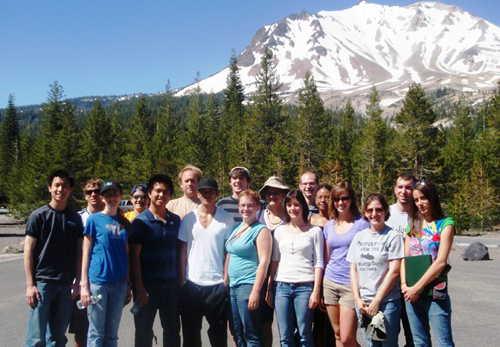
One of the program requirements is to keep in touch with students and track their progress. Many of our interns have gone onto graduate school in a variety of fields including biology, astronomy, chemistry, optics, teaching, and even medical school. One student is in space physiology and another got a Masters degree in science writing. We are all so proud of our students!
What first sparked your interest in science and astronomy in particular?
I always liked science and astronomy. I grew up in a family of science nerds. My Dad was an avid amateur astronomer. He had a scrapbook filled with pictures of planets taken by Pioneer and Voyager. He was always dragging us out in the middle of the night to look through a telescope at some little faint, fuzzy thing - usually in our backyard in the middle of a freezing-cold Boston winter. I wanted a better way of looking at pictures than through a telescope.
I wanted to be an astronaut as a kid. Around 10 or 11, however, I found out my eyesight was too bad to qualify, and I was totally crushed. If I couldn't become an astronaut, I decided I'd work in Mission Control, thinking this would be the closest I could come. While in high school, a PBS program called "Neptune All Night" provided a live feed from JPL as the Voyager II spacecraft flew past Neptune and transmitted pictures back to Earth. Since this was the pre-Internet era, the scientists, including Carl Sagan, went to JPL (NASA Jet Propulsion Laboratory) and sat in front of big computer monitors viewing the images. As the cameras ran, they captured the scientists' awe-struck reactions. They were the first people ever to see the satellites of Neptune. Just watching the excitement on these scientists' faces as they looked at these first pictures was thrilling. They were speculating that one image could be a ridge, another looked like a crater; they questioned how something was formed and what something was made of. They had no idea, but they were giddy with excitement and probably exhaustion. The idea that this was the first time humans had set eyes on the surface of another world was so amazing and one of the coolest things ever.
Think back to the golden age of exploration of our planet when people were sailing and setting eyes on the North American continent for the first time. This is the golden age of planetary exploration. We're seeing these worlds as worlds, not just as dots of light, but as real places for the first time. Being able to look at pictures of another place for the first time -- that's what sold me! The fact that the world's top scientific minds had no idea what they were looking at was fascinating and captured my imagination.
Did you ever get to work in a "Mission Control" environment?
In college, it took me awhile to get from physics to astronomy to planetary science, but in graduate school I had the privilege of being an associate of the Galileo imaging team. We had the Internet by then, so I was actually disappointed we didn't get to sit around in a big room at JPL and look at the pictures coming in. But it was similar because the pictures came in and were processed at JPL. I was the grad student at the computer who could type fast, so I was typing, downloading, and displaying the images as we all hunkered around a computer. We were looking at pictures of Europa for the first time, so I did get to realize a childhood aspiration. It was amazing! And I got to help with some of the observation plans and name some craters on Europa, which was so cool.
How did you become involved in authoring books?
While in graduate school, the Internet was young and it was hard to find good information on the web. About.com, a company that provided the best links on the web on various topics, hired me to run a website for kids on space and astronomy. Every week, I'd write a little article and I'd come up with links for more information. There was a chat room and games. I ran the site for a couple of years, and it was really fun. It kept me up-to-date and was a good experience learning to write on a basic level. In 2000, I received an email message out of the blue from a book agent who had a publisher who wanted to write a book on astronomy. She had seen my website and asked if I was interested. I said, "Sure, I'll write a book! That's so cool!" My partner and I co-wrote Everything Astronomy. Ironically, About.com decided to remove their kids' websites about a month later, so I redirected my time into writing books. Since then, we've written 15 books.
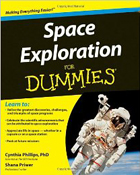 It's been really enjoyable digging into a topic. For example, our latest book, Space Exploration for Dummies, gave me an excuse to read about all the stuff I thought was really cool. For example, when we were writing Space Exploration, many of the details about the early Soviet missions had only become declassified in the last ten years, so I had never learned a lot of it. One interesting fact is that Yuri Gagarin, the first person to orbit the Earth, didn't actually land with his spacecraft but parachuted out and landed in a farmer's field. You can imagine the farmer's frightened reaction! That fact hadn't been released because technically you had to land with your spacecraft in order to get the certified record for the first space flight. We've included all kinds of wonderful stories like that in the book.
It's been really enjoyable digging into a topic. For example, our latest book, Space Exploration for Dummies, gave me an excuse to read about all the stuff I thought was really cool. For example, when we were writing Space Exploration, many of the details about the early Soviet missions had only become declassified in the last ten years, so I had never learned a lot of it. One interesting fact is that Yuri Gagarin, the first person to orbit the Earth, didn't actually land with his spacecraft but parachuted out and landed in a farmer's field. You can imagine the farmer's frightened reaction! That fact hadn't been released because technically you had to land with your spacecraft in order to get the certified record for the first space flight. We've included all kinds of wonderful stories like that in the book.
* Watch a video of Dr. Cynthia Phillips giving a one-minute summary of her work.
* Learn more about Cynthia and her fascinating research in her full interview.
